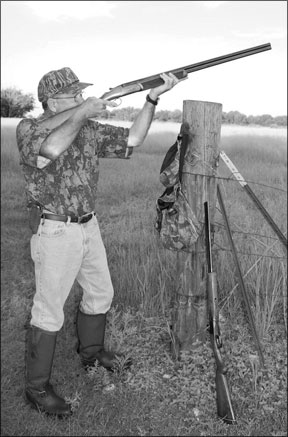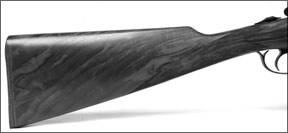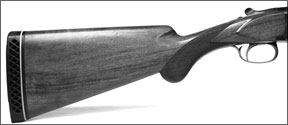Seasoned bird hunters are often more interested in savoring quality time in the field than in trying to crush targets with big guns and big shells. Many are turning to sub-gauge offerings such as the tiny .410 to help them relive the memory of what might have been their first shotgun experience.
Unfortunately for some shooters, that first experience may not have been as encouraging as it could have been. While a .410 has less recoil and is easier for a young, slightly-built shooter to handle, they are not the best choice for a new and inexperienced shooter.
The main problem is with the pellets. A standard .410-bore 2.5-inch shell with one-half ounce of No. 8 shot will contain about 164 pellets, compared with about 410 pellets in a standard 12 gauge 2.75-inch shell with 1 ounce of No. 8 shot. Increase the shot size to No. 6 shot – an effective dove load in a .410 – and the shot differential is about 155 pellets in a .410 3-inch shell with 11/16 ounces of shot, compared to about 281 pellets in a 12 gauge 2.75-inch shell with 1.25 ounces of shot.

Less shot means more potential target-missing holes in a pattern and requires a shooter to be really centered on a clay or bird to produce consistent hits. Veteran shooters with years of shotgun experience are just more suited for making sure they put a .410 on target than a novice taking his or her first shots with a scattergun.
The other factor favoring the tiny poppers is that veteran shooters are often interested in upgrading their “toys” and are looking for high-quality, easy-shooting fine firearms for their seasoned shooting experiences.
Both of the shotguns in this match fall within the parameters of quality shooting tools where the owner is not opposed to spending a few more dollars to satisfy “big boy toy” needs. The two test shotguns we put to field and target use were the Padrone Snipe Model that retails for about $6,795 and the Browning Superposed Lightning Model available in the used shotgun racks for about $4,500. These two firearms probably would not be the choice for a bargain shotgun shopper, but both have good followings of owners who have a taste for a little finer wing-shooting experience.
We liked the looks and feel of both the test guns – not too fancy and yet far from plain – and enjoyed our shooting experiences both on the range and in the field. Our ratio of shots to hits was nearly identical to fellow field shooters using massive 12 gauge shotguns in their attempts to knock down darting doves, so we have no complaints about the effectiveness of the two sub gauges.
For our target range time, we selected Winchester AA Super Sport Sporting Clays 2.5-inch loads with one-half ounce of No. 8 shot that produced an average muzzle velocity of 1,300 fps. Field loads for our test were Federal Hi-Power 3-inch loads with 11/16 ounces of No. 6 shot that produced an average muzzle velocity of 1,135 fps.
Recoil with both loads was negligible, as expected, and there were no malfunctions with either shotgun with any of the test ammunition. Patterning performance with both loads and both barrels of each shotgun was a surprise, as noted in the individual assessments of the shotguns.
Heres our test report:
Padrone Snipe Model
.410 Over and Under, $6795
Slim, trim and easy to handle, this shotgun lives up to the advertised slogan of: “Round Body. Small Action. Game Guns.”
We were impressed with the feel of this sub-gauge shotgun right out of the case. It is very close to being one of the best-balanced shotguns we have ever handled – quite a plus for a .410.

Dimensions of the Padrone were fairly typical of a field gun. The drop at the comb was 1.5 inches and the drop at the heel was 2.5 inches, with a length of pull of 14.5 inches and an overall length of 46.75 inches.
Although the solid barrels of the Padrone were 29.25 inches long, the shotgun tipped the scales at just over 6.25 pounds. We found this to be a good, light carry weight for a field gun.
We did have some original concerns about the checkered wood butt plate – a nice and classy touch for a high-end shotgun – there were no problems with shoulder slippage. Rubber recoil pads tend to fit and stay in the shooters shoulder better than wood or hard plastic.
In the dove field and on the patterning board is where the Padrone really shined. Members of our test team were able to make more and harder hits on birds, particularly with the No. 6 shot shells. Tighter chokes may have given the Padrone a slight edge with the birds, although the longer barrels just seemed to make the .410 easier to push through targets. Patterns with both barrels of the Padrone produced 50-50 results (half the pellets above the center and half below) with the No. 6 shot and 60-40 results with the No. 8 shot. Having a field gun shoot where you look is a good thing, and we found the Padrone performed this function very well.
Another plus for the Italian product was a trigger pull for both the bottom and top barrels of a crisp 4 pounds. The light touch off really helps a shotgun shooter put his or her pattern in the right place at the right time.
We also liked the way the Padrone ejected both the 2.5- and 3-inch shells with authority, and the ease in which the barrel selector on the safety (similar to the system used on Berettas) allowed for switching first shots from barrel to barrel.
Browning Grade 1 Lightning
Superposed Model .410
Over and Under, $4500
The look and feel of this vintage .410 provided us with both a trip down memory lane and the anticipation of some quality shooting time.
A small-gauge version of the first over-under produced by Browning, the Superposed is the last shotgun designed by legendary firearms creator John Browning.

To say that the various models of this shotgun that was discontinued in 1986 are among the most popular seasoned shooting tools sought by veteran wingshooters would be an understatement. The Belgium-made Superposed has long been a highly prized over/under, particularly in the smaller gauges.
The test gun that we obtained from a family collection for this match up was manufactured in 1966, and while it showed a little wear, the .410 still performed like a quality shooting tool.
Although the Browning sported 26-inch barrels, its overall weight was 6.75 pounds – just a little more heft than the Padrone.
The drop at the comb was 1.75 inches, and the drop at the heel was 2.25 inches, with a length of pull of 14.5 inches. With similar dimensions to the Padrone, the main difference was with the barrel length.
Back when the Browning was manufactured, short barrels were standard features for a field gun. Today the trend is for longer barrels, with the idea that more length will help smooth out a swing. We found this change in technology did indeed give the Padrone a slight edge in performance in the field. In our skeet field tests, the Browning produced better results than the Padrone.
The trigger pull on the Browning was 5 pounds for the bottom barrel and 5.5 pounds for the top barrel. Not quite as good as the Padrone, but not a major problem either.
We experienced no functioning problems at all with the Browning, which handled both the 2.5-inch shells and 3-inch shells very well. On the patterning board, the Browning produced 50-50 patterns with both barrels using the No. 8 shot and 40-60 patterns with the No. 6 shot. These results tracked well with the Brownings performance on the target range and in the field, with better results on clays than on birds.
The after-market recoil pad provided a firm shooting foundation, but with the very limited recoil of a .410, we did not consider it a plus or minus in our tests.
Our overall impression of the Browning was that this is a quality, veteran firearm that would find favor with the shooting crowd members who have a touch of nostalgia in their bones. This shotgun is a tribute to the genius of John Browning and would be a fine choice for a high-end shooting experience.


























